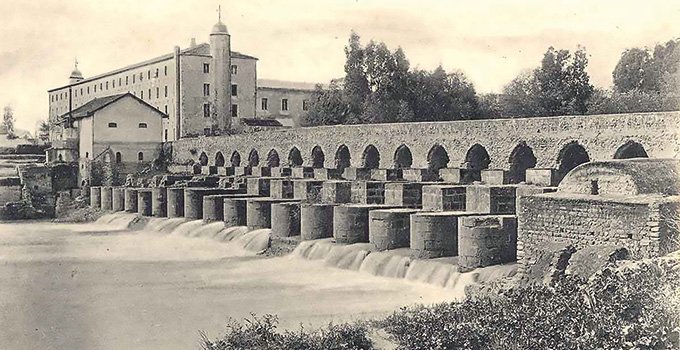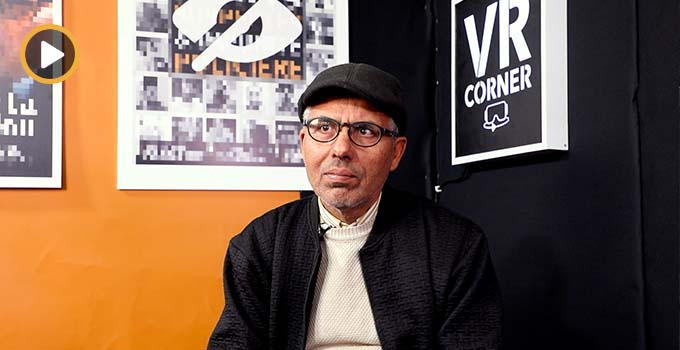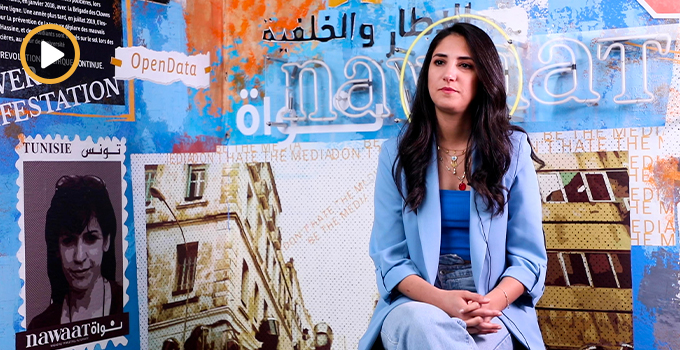
Chouftouhonna began three years ago with « a collective of women who asked themselves about the conditions of access to art and culture for themselves and their sisters in Tunisia ». Unlike a number of cultural events and festivals organized in the capital, the festival’s founders blend in with their surroundings. Two dozen organizers and some 50 volunteers in black t-shirts and white lab coats dash from place to place, up and down stairwells, hoisting tables in and out of rooms, hands full of coiled wires, colored markers. With 250 artists from 51 countries, this year’s program covered a gamut of artistic expression: musical concerts, stage performances, film screenings, poetry readings, photography exhibitions, tattoo sessions, visual and graphic art installations and a craft market. On Saturday and Sunday, every workshop offered—from voguing and soccer to electronic sound-making and illustration—was filled. Rare vacant rooms and spaces were quickly taken over for rehearsals, cigarette breaks and spontaneous debates.
Running the show… and being in it
Ghaya Belhadj, a senior in high school, participated in last year’s festival as a volunteer and artist. This year, Ghaya is a part of the organizing committee. Compared to the previous edition, which took place over two days and was held at Mad’art Carthage, Ghaya admits that the organization is much more challenging—for all the right reasons. Double the number of artists from across four continents responded to the call for participation. Plus, the new venue is significantly larger and more accessible. « We’ve succeeded in creating our space for expression for people who identify as women, it’s a space in great demand, the kind of space of which we don’t have enough ». Asked about the particularities of the current edition, Ghaya replies that « more than specificity, I would speak to the continuity of activism in art, of opening a space for artistic expression ».
Sitting at the edge of the courtyard—whose astro-turf covering serves the dual function of soccer field and chill space—for a moment’s pause, Syrine Augustine Amy shares her enthusiasm for the people and activities that animate the festival. Like other volunteers, Syrine bounces between carrying out her volunteer duties and taking part in workshops. « It’s easy to enter into conversations with people and to speak out and to say what you really think » she says. Is this not normally the case? « Listen », she says, her tone becoming serious, « in Tunisia, I avoid showing my real personality, my real interests to everyone. We have an old proverb which says, if you’re speaking with someone who doesn’t understand you, it’s a loss of time, he’s never going to get your point of view or vision of things ».

Linking art and feminist struggles
« I was raised to say I’m Moroccan, I’m Arab, I’m Muslim ». For Nidhal Azhary, founding president of the Union Féministe Libre in Rabat, this sort of mantra captures the implications of colonization and political pressures on identity. During a panel discussion on « Gendered bodies and multi-layered representations, » Nidhal speaks with passion about Amazigh culture in Morocco.
« You’re welcome to live on my land, it’s everyone’s land », she says with fervor. « But the day you start stepping on who I am in terms of laws, in terms of policies, then we have a problem. Teach me Arabic. I’ll teach you Tamazigh. But don’t push Arabic and not accept Tmazigh ». Comparing Maghreb customs and legal codes before and after Islamization and French colonization—many of today’s penal codes date from the colonial period, she points out—Nidhal explains that there used to be more equality between men and women in terms of inheritance and land ownership. Over time, Amazigh culture has been repressed, and Amazigh tribes living outside of cities excluded from access to health and education. She describes ongoing rights movements led by women in the rif. Her reflections prompt those present to question the need (or not) to cling to a specific identity and the different social, political, economic factors that shape it.

Questions related to language, history and self-expression are a fascination for literature teacher and poet Sagia Bassaid, who is participating for the second time in Chouftouhonna. Sagia stands close to her installation: on four letter-sized sheets of paper suspended horizontally before a backlight, words and phrases in French, Arabic, Spanish, and English fill the white space with shapes and lines. Echoing comments made by a French actress who described the challenges of working in a male-dominated industry, Sagia points out the discrimination she faces as a woman in the domain of literature and poetry. She also tells of editors who doubt the « legitimacy of the French language » under her pen—Sagia, who lives in Austria, is French-Algerian. Growing up in France, Sagia’s parents spoke Arabic at home. She remembers once asking her father to spell his first name in French. Glancing at what he had written, she told him « But you wrote it in Arabic. He looked at me and said, ‘I’m sorry, daughter, when I arrived in France they just taught me to write my last name to sign the papers ». What Sagia expresses in her work is the « difficulty to find a language to express yourself », a struggle which she identifies among the long-term and often subconscious effects that colonization has on successive generations.

More than composing an event, growing a network
Anna Antonakis, who has spent the past several years between Berlin and Tunis conducting doctoral research on gender renegotiations in Tunisia since 2011, is in charge of Chouftouhonna’s talks and panel discussions. She also highlights the importance of the festival’s continuity. For Anna, a longer event this year means that « artists can really meet and start to build trust and exchange on a deeper level ». Part of the goal, she adds, is to develop a sustainable network of artists and activists, to « create a transnational collective over the long-run ». By the afternoon of the fourth and last day, a sort of premature nostalgia sets in among organizers, volunteers, artists and festival-goers. As evening approaches, some struggle with the idea that it will be another year before this sort of encounter takes place again. At this, Anna recalls discussions with participants who evoked « the creation of utopia and utopian spaces…where you feel seen, where you feel free ».
If the idea behind a feminist art festival seems broad, it is. « Chouftouhonna is an artistic initiative of course! But also, and above all, it is activist », the organizers assert. In fact it is the open-endedness of the event, the broadness of topics raised and questions posed, which leaves free rein to individuals from different backgrounds to find and interact around common themes. And this, it seems, is the essence of the event’s activism: the complete takeover of a space for few short days each year and filling it to capacity with art, creative expression and dialogue.





iThere are no comments
Add yours